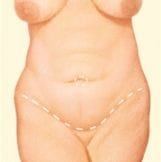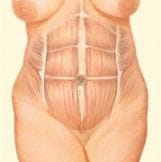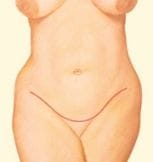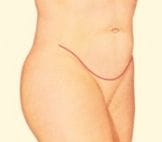Also known as a tummy tuck, an abdominoplasty removes excess fat and skin, and in most cases restores weakened or separated muscles.
What it won't do: An abdominoplasty is not a substitute for weight loss or an appropriate exercise program. Although the results of an abdominoplasty are technically permanent, the positive outcome can be greatly diminished by significant fluctuations in your weight. For this reason, individuals who are planning substantial weight loss or women who may be considering future pregnancies may be advised to postpone an abdominoplasty. Also, an abdominoplasty cannot correct stretch marks, although these may be removed or somewhat improved if they are located on the areas of excess skin that will be excised, (generally areas below the belly button).
Procedural Steps - What happens during tummy tuck surgery?
Anaesthesia
Abdominoplasty is done under a full general anaesthetic.
The incision
An abdominoplasty requires a horizontally oriented incision in the area between the pubic hairline and navel. The shape and length of the incision will be determined by the amount of correction required.
Through this incision, weakened abdominal muscles are repaired and sutured and excess fat, tissue and skin are removed.
 |  |
 |  |
 |  |
Repair of Abdominal Muscles
In some individuals (especially those post multiple pregnancies), the rectus abdominus muscle may sit far apart (diastasis or divarication of rectus). This is approximated with permanent sutures during an Abdominoplasty. Sometimes, laxity of the lateral abdominal muscles is also present, which can be tightened using permanent sutures for muscle plication. Rarely there is a horizontal excess that contributes to a bulge, this may also be repaired if required.
Repair of Abdominal Hernias
Co-existing with a weak abdomen wall or in particular, with previous abdominal surgery, weakened areas on the abdominal may be associated with herniation of intra-abdominal contents. This may be protrusion of the fat surrounding the bowels or even the bowel itself. Usually, these protrusions occur between layers of the abdominal muscles, or at a weak point such as around the belly button, or even through a previous abdominal surgery site. If you have an abdominal hernia, this is usually diagnosed and assessed in your preoperative consult and you will be required to see a general surgeon who will be able to be present during your abdominoplasty procedure to repair your hernia at the same time.
During a hernia repair, the hernia will be pushed back and the weakened area oversewn. At times, the abdominal defect is large enough to warrant placement of mesh. The mesh is like a flat piece of fishing net made of a mix of dissolving and non-dissolving suture material; this is sewn into the abdominal wall to reinforce its strength as well as preventing future herniation of intra-abdominal contents. If you have further questions about hernia repairs, please discuss this further with your general surgeon.
Your Umbilicus (Belly Button)
An incision is usually made around your umbilicus to preserve it and its stalk (its blood supply and connection into the abdominal cavity) during the surgery. At the time of closure, when the abdominal wall skin has been pulled down and tightened, an opening will be made for the umbilicus to be pulled through. It is then inset into the new opening with sutures. In principle, it is not a new umbilicus, it is the original belly button brought through a new hole. If you have a hernia or multiple keyhole surgeries through your umbilicus previously, there is a possibility that your umbilicus' blood supply may not be able to be preserved during an abdominoplasty surgery. If this is the case, your umbilicus will be removed during the surgery, and you may not have a belly button after your procedure. The likelihood of this, and the decision to remove your umbilicus will be discussed with you during your consultation to ensure that you are willing to accept this outcome as part of your procedure.
Closing the Incisions
Sutures and skin tapes are used to close the skin incisions.
Specific Risks of Abdominoplasty
The decision to have an abdominoplasty is extremely personal and you'll have to decide if the benefits will achieve your goals and if the risks and potential complications are acceptable. Our surgeon and staff will explain in detail the risks associated with surgery. You will be asked to sign consent forms to ensure that you fully understand the procedure you will undergo and any risks or potential complications.
Possible risks of abdominoplasty include:
- Unfavourable scarring
- Bleeding (haematoma)
- Infection
- Fluid accumulation or seromas
- Poor wound healing
- Skin loss
- Necrosis or loss of the umbilicus (belly button)
- Blood clots
- Numbness or other changes in skin sensation around the scar and on the abdomen
- Anaesthesia risks
- Skin discoloration and/or prolonged swelling
- Fatty tissue found deep in the skin might die (fat necrosis)
- Major wound separation
- Asymmetry
- Recurrent looseness of skin
- Pain, which may persist
- Deep vein thrombosis, cardiac and pulmonary complications
- Persistent swelling in the legs
- Nerve damage
- Possibility of revision surgery
- Suboptimal aesthetic result
Most of the risks are very uncommon, and some people (with particular health problems or specific body shapes), may be at higher risk for specific complications. Your surgeon will discuss this with you during your consultation if any of these risks are specifically pertinent to you.
Although abdominoplasty surgery can be an effective procedure where the benefits significantly outweigh the risks, like everything in the practice of medicine and surgery, it is not an exact science. The degree of surgical success can be altered by how each individual's body responds to surgery and healing. Although good results are expected, there is no guarantee. In some situations, it may not be possible to achieve optimal results with a single surgical procedure; revision surgery may be necessary.
Be sure to ask questions: It's very important to ask questions about your procedure. It's natural to feel some anxiety, whether it's excitement for your anticipated new look or a bit of preoperative stress. Don't be shy about discussing these feelings and any specific concerns with your surgeon or any of our staff members.
Postoperative recovery
Following your surgery, dressings are applied to your incisions, and you will be wrapped in an elastic foamy tape to minimize swelling and to support your abdomen as it heals. Two draining tubes will be placed under the skin to drain any excess blood or fluid that may collect.
You will be put placed in a bent position with pillows under your legs to prevent excessive stretching force on your wound. In-hospital physiotherapist will also teach you how to get out the bed to minimise straining of the abdominal muscles and skin. Your posture will often be hunched over for at least 2 weeks. Hospital stay varies from 5-7 days depending on the drains. Once drainage has stopped, the tubes will be removed. Often, your dressings will be replaced by a garment prior to your discharge. Restrictions after an abdominoplasty include no driving for 2-3 weeks and no lifting or heavy activities for 8 weeks.
To find out more about postoperative care,please click here.
The Costs associated with Abdominoplasty
There are specific clinical criteria that need to be met for an abdominoplasty to qualify for a medical rebate. You will only be covered by your private health fund for hospital, surgical and anaesthetic fees if you qualify. You must carefully review your health insurance policy to make sure that you are covered for this particular procedure. Use the item number given to you by our staff (on your financial consent) when you talk to your insurer.
Results and Expectations
Your abdominoplasty surgery will result in a flatter, firmer abdominal contour that is more proportionate with your body type and weight. The final results may be initially obscured by swelling and your inability to stand fully upright until internal healing is complete.
Previous abdominal surgery may limit the potential results of a repeat abdominoplasty. In women who have undergone caesarean section, the existing scars may often be incorporated into the new scar. As for those who have had a midline incision extending above the umbilicus (belly button), a midline scar will be present in addition to the lower horizontal scar.
Within a week or two, you should be standing tall and confident about your new slimmer profile. This result should be lasting. As mentioned before, any significant change in weight or pregnancy may compromise your long-term result.
Vocabulary to Know
- Abdominoplasty: A surgical procedure to correct the apron of excess skin hanging over your abdomen, also known as 'tummy tuck'.
- Diastasis: Condition in which abdominal muscles have separated, also called 'rectus divarication'.
- General anaesthesia: Drugs and/or gases used during an operation to relieve pain and alter consciousness.
- Haematoma: Blood pooling from bleeding beneath the skin.
- Hernia: protrusion of abdominal contents (fat and bowel) through or between the abdominal muscles causing a lump or bulge of the abdomen.
- Sutures: Stitches used by surgeons to hold skin and tissue together.
- Umbilicus: the belly button.
(Some Information & Illustrations are courtesy of the American Society of Plastic Surgeons).

